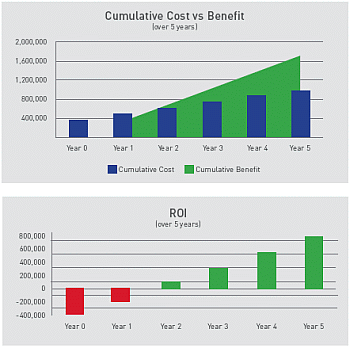Published on the 07/01/2014 | Written by

As technology plays an ever-stronger role in modern business models, predicting and measuring productivity gains from technology investment is becoming paramount to getting project sign off…
The justification step in any project is single-handedly responsible for more sleepless nights, cold sweats and pre-submission stress then any other. In my opinion this is a direct result of not following a structured process to create the business case to establish solid reasons explaining why the organisation should invest the required funds into the proposed project. In the book I outline the full business case process, but here I will focus on how to conduct a cost benefit analysis and calculate the projected return on investment (ROI) as the calculation of benefits in monetary terms is not always a simple task. It requires thorough business analysis and realistic estimation of the future. Unfortunately, this type of business analysis is sometimes perceived as too complex, and as a result some people either bypass this step altogether or include high-level, unsubstantiated figures, which are critically evaluated by the management team. Benefits must be included to offset the project cost and calculate the return on investment. Without this, the business case becomes unbalanced and forces the management team to review a project cost submission rather than a project investment. Benefits should be presented in three general categories: 1. Annual tangible benefits 2. One-off tangible benefits 3. Intangible benefits As an example, let’s say the organisation has an older payroll application and this business case is for the purchase of new payroll/ HR/rostering plus time and attendance solution. Through the implementation of a proposed system, the expected outcomes may be: So, for example, if 100 people currently enter timesheets and it takes 15 minutes per person per fortnight at the moment, and this effort will be reduced by 10 minutes with the introduction of a new system, the annual productivity benefit is: 100 people x $36 /hr x 10/60 min x 26 fortnights = $15,600. Cost-benefit analysis and return on investment It is usually depicted graphically in a combination bar and area chart, which instantly presents the viewer with the magnitude of the cost and the benefits. The first graph shows the cumulative cost increasing annually by the amount of the ongoing costs. The cumulative benefit is illustrated by an area chart to differentiate it from the cost. The graph clearly illustrates that after the first two years, this solution will yield more benefits than its invested cost. This intersection is called the breakeven point. After this point is reached, the benefits yield positive returns. To view the actual breakeven point, we will need to refer to the return on investment analysis. The return on investment (ROI) simply aggregates the costs and offsets these by the benefits. The ROI forms a cornerstone of traditional business cases because it clearly illustrates the financial position and returns of the project. The ROI calculation displays how long it will take the benefits to cover the project cost and the magnitude of positive benefits in subsequent years. For technology projects, it is common to evaluate such investment over five to seven years. In the ROI illustration below, the red bars demonstrate that the project costs offset resulting benefits. The green bars represent the positive yield, where the benefits exceed the costs, so we can see that the project total cost will be recouped in about one and a half years and the overall benefit over five years will equate to about $700,000. Including the ROI figures in your business case, changes the whole focus of the business case from “Why is this costing so much” to “When can we start? When will it be ready?” You must, however, make sure that all the details equate to all the numbers and statements presented in the preceding sections of the business case. If there are errors, the business case will lose credibility. This condensed excerpt from ‘A practical guide to selecting and justifying the right business technology’ by Alex Gelman was published with consent from Consult Point. For more information, visit www.consultpoint.com.au …
These benefits are yearly benefits defined in real monetary terms, either through cost savings, freeing up working capital, productivity improvements or income increases; for example, productivity benefits associated with the elimination of manual timesheets through electronic time and attendance.
These benefits are also defined in real monetary terms, either through cost savings, freeing up working capital, productivity improvements or income increases, but are usually realised within the first one to two years of completing the project; for example, current system upgrades planned in six months are no longer required.
These benefits cannot be calculated in real monetary terms, but are important nevertheless, for example indirect contribution to corporate growth and culture such as social, environmental and productivity considerations.
Having calculated the total cost of the proposed project and its benefits, completing the costs-benefit analysis becomes a very simple task.
































